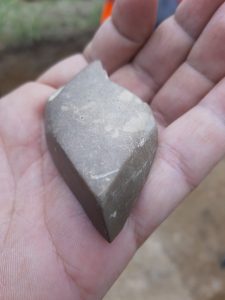06 Oct Raw material determination of polished stone tools
In the ERCA centre it is possible to make use of the possibility of scientific determination of a raw material of polished (ground) stone tools. A first step is a macroscopic determination of a raw material with a use of the comparative collection. Another step is a raw material determination without any damage under the stereomicroscope. Measuring of magnetic susceptibility by a portable kappameter has proven to be very suitable for the differentiation of some types of metabasites or for the determination of patinated serpentinites (Přichystal, 2013, 45). The next step is to prepare a thin section and to study it under polarizing microscope, which usually enables a reliable classification of the rock.
Electron microscopy is another possibility for a fast determination of a chemical composition of an analysed rock (SEM method and microprobe method, see a description of the electron microscopy). Measured values of trace elements can be compared to the values measured on the rocks coming from the primary outcrops, which are deposited in the comparative collection, or which were collected for this purpose directly at the outcrops. It is possible to mention other methods as well, such as the cathodoluminescence for the study of marbles or the differential thermal analysis for the research of lutaceous rocks.
In the frame of the ERCA Centre, the raw material determination of polished (ground) stone tools and other lithic industries is performed in a cooperation with geologists Mgr. Petr Gadas, PhD., and Prof. Antonín Přichystal, DSc., from the Institute of the Geological Sciences at the Faculty of Sciences of the Masaryk University in Brno.
References:
Přichystal, A., 2013: Lithic raw materials in prehistoric times of Eastern Central Europe. Brno: Masaryk University.

A fragment of the Eneolithic stone-axe from a grey siltstone found at the excavation of barrows at the Hlinsko-Kouty site near Lipník nad Bečvou in central Moravia. Photo by O. Mlejnek.

A selection of Neolithic and Eneolithic polished stone tools found in a surrounding of the Hlinsko village near Lipník nad Bečvou in central Moravia. Photo by O. Mlejnek.





